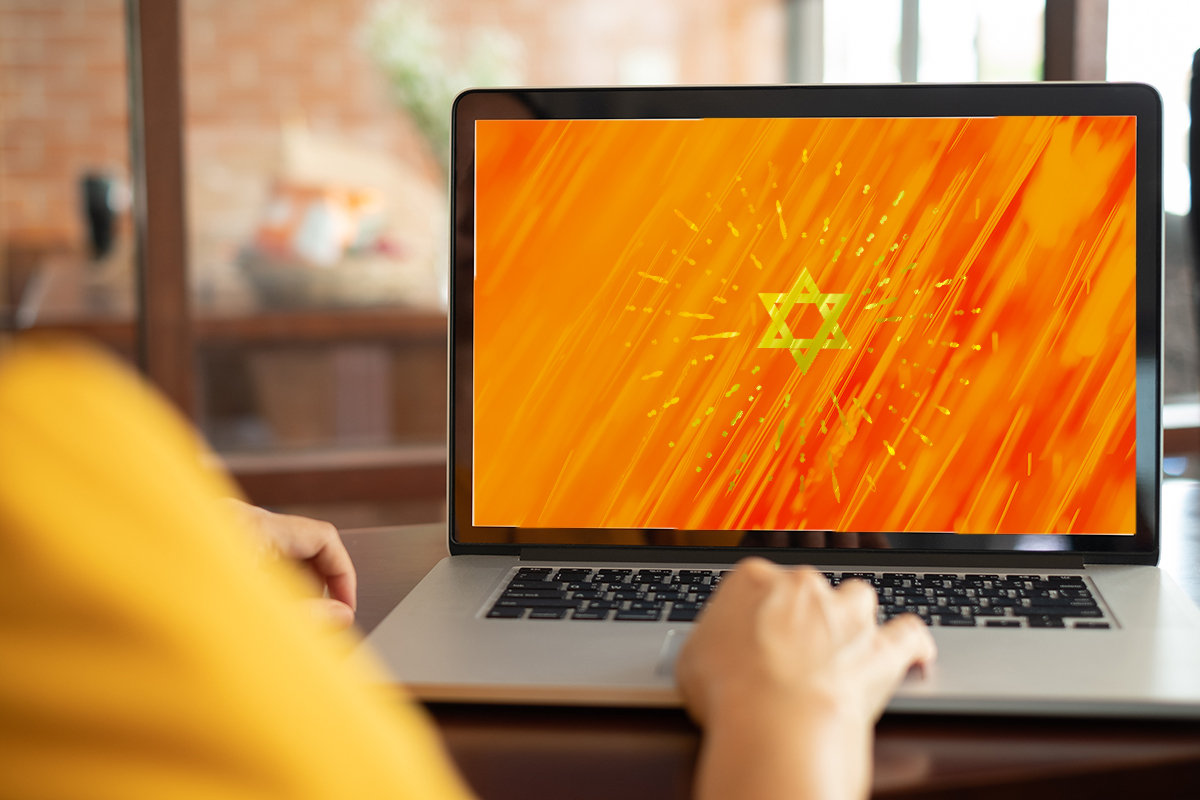It sounded like muscle memory, if that’s possible. As the rabbi lit the final candle, the blessings he sang soared through my ears like birds in echelon, landing somewhere previously untouched. He had definitely sung them a thousand times before, and sang so nonchalantly that for a moment I felt like I knew them from memory too. But no — it was definitely my first time. My first Hanukkah, and it was all happening over Zoom.
In the wake of the coronavirus pandemic, my choice to convert was terribly timed. My nearest synagogue was holding virtual services every week, and baruch ata adonaiii just did not hit the same through video call. After navigating weeks of what felt like a forced connection, I felt like I was failing as a Jew. The Shabbat candles on my desk stared at me longingly, as if begging me to blow them out and put this whole thing to rest. I shut my laptop, interrupting the rabbi mid-sentence, and crawled into bed with my phone instead.
Let me explain how I got here. Fifteen years before this moment, when I was a child, my Pentecostal mother would tell me stories of our Sephardic Jewish relatives that had emigrated from Gibraltar. Their arrival point of Charleston, South Carolina had a strong Sephardic community and even a Sephardic cemetery where the various Abrahams and Isaacs of our family had been buried. These people were all dead already, frozen in the past, and this combined with the fact that we were now a Christian family made me think Sephardim were extinct.
Sephardim everywhere are familiar with the continual urge to “prove” ourselves, having had our identities ripped from us and contorted over hundreds of years: immigration from our places of origin; last names lost or altered; assimilation to more widely accepted religions and practices. My case was the third. When my mother told me that we were Jewish, I didn’t understand any of it. As a young girl growing up in the highly Ashkenazi-dominated United States, I didn’t check any of the boxes of what I thought a Jew was. With an impossible-to-ignore Spanish surname, any Jewish remnant inside of me seemed to be dissolving by the minute.
Interestingly enough, however, whenever the question of heritage would come up, I clung to my Sephardic roots with an iron grip. In the U.S., people hardly know about Gibraltar’s existence, let alone that there’s more than one kind of Jew, so I always found joy in telling my story. What eventually started to bug me, however, were the questions that followed me everywhere — “If you’re Jewish, why don’t you go to synagogue? Did you have a bat mitzvah? Why not?”
After years of it, I finally figured that the only way I would ever feel fulfilled in my Jewish identity was by officially converting. Judaism is an ethno-religion, I thought, and I had only ever stepped up to plate for half of it.
So now returning to the vignette of a Shabbatically-defeated Jew scrolling through Twitter, it turns out that the algorithm had my back that night. What reeled me in first was a back-and-forth between two Jewish users arguing over the supremacy of Hebrew among Judaic languages (why can’t we all just get along, by the way?). It was my first exposure to what I would later discover to be #Jwitter (or #JTwitter; yes we argue about that, too), and it was marvelous.
Out of curiosity, I clicked one of their profiles and saw that she was Sephardic, too, but from Brazil. It was the first Sephardic person I had encountered outside of my family, so I followed her. To my surprise, she did the same, and within minutes we were chatting. The chance to practice my Portuguese was exciting enough, but I was shortly thereafter made privy to a sphere of Jewishness that I’d never encountered.
My new Twitter friend enlightened me on the large population of Sephardim in the city of Recife, where she lives, and the words she used to describe her journey were the same that I had used in my own relationship with Jewishness — a relationship more cultural than religious; the pressure she felt to convert to feel validated; all of it. I learned about Bnei Anusim and ba’al teshuva, and I felt more seen than I ever had. (It also helped that she was red-haired like me.)
The solution I had searched for my entire life turned out to be thousands of miles away, but it encouraged me to dive into the internet head-first to find my community, to unearth it with my own hands. Suddenly the very same technology that left me feeling deflated in my conversion process gifted me opportunity after opportunity to learn and connect.
I made many more Jewish mutuals through Twitter, but as I looked through other platforms, I didn’t feel the same pull. Aside from various short documentaries and songs in Ladino, there was a tremendous lack of Sephardic content on YouTube. Seeing as I have a decent following on the site, I decided to make my debut there and explain my Jewishness to my subscribers.
“I don’t know how to start this without it sounding like a coming-out video,” I joked. It was a short explanation of Sephardic history, my family’s history, and common misconceptions about Jews that I felt needed attention. The response was everything I had hoped for, but nothing I had expected: people recommending books to read; infatuation with the small excerpt of Ladino I spoke; and a ton of other Sephardim welcoming me with open arms.
The reception of the video was so meaningful to me because I had never claimed my Jewishness in such a public arena before. I was apprehensive to do so, but the warm embrace of online Jewry offered itself with no hesitation.
Although the pandemic has made the beginning of my path to Judaism synonymous with solitude, this stint on the Jewish side of the net has taught me some valuable lessons I’ll carry with me even with this is all over.
As Jews, we need each other. Community is an essential part of Jewishness, but my fears of rejection held me back from it in the time when I needed it most. There is always someone who has felt what you feel, or had the same doubts that you’ve had.
It was also crucial for me to “de-Americanize” my perception of the Jewish world to fully understand it to its core. We come from all walks of life, and in the Ashkenazi-dominated U.S., this was easy to forget. The chance to feel seen isn’t confined to the borders of my country, to the contrary — I might have more in common with someone halfway across the world.
Further, conversion isn’t everything. My rush to get involved religiously manifested not only as invalidation of millions of non-religious Jews, but also as internalized shame for circumstances that weren’t my fault as a Sephardic person in the first place.
And finally, culture is everything. At the end of the day, when I wipe the tears from my face because I didn’t understand the message at Shabbat, I still know how to make amazing shakshuka and the sweetest buñuelos. I still have Ladino, which I’m so eager to explore. I have so many more outlets that reassure me than ones that confuse me, and for now, I think I need to spend more time there.
Evolutions in my identity don’t have to be such a serious matter, and can instead manifest in wonderful, fun forms such as social media. Involving myself online reminded me of the sweet simplicity of connecting, which the pandemic had starved me of. It’s helped me to appreciate the beauty of my eagerness, but also to acknowledge that my relationship with Jewishness is one that will continue to change over the course of my entire life. Hundreds of other inner developments in my being happen everyday without me toiling over them, so why should this one be any different?



